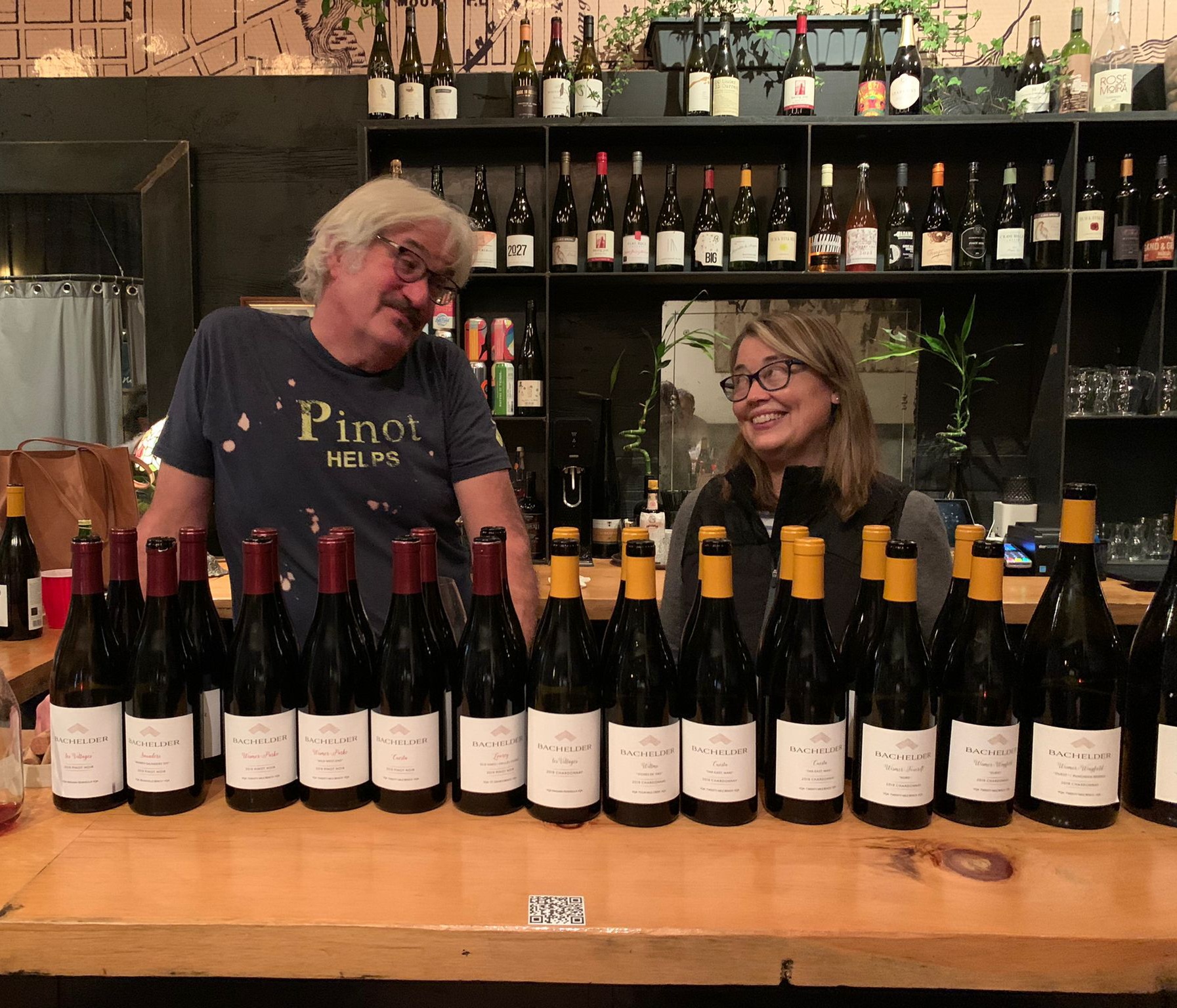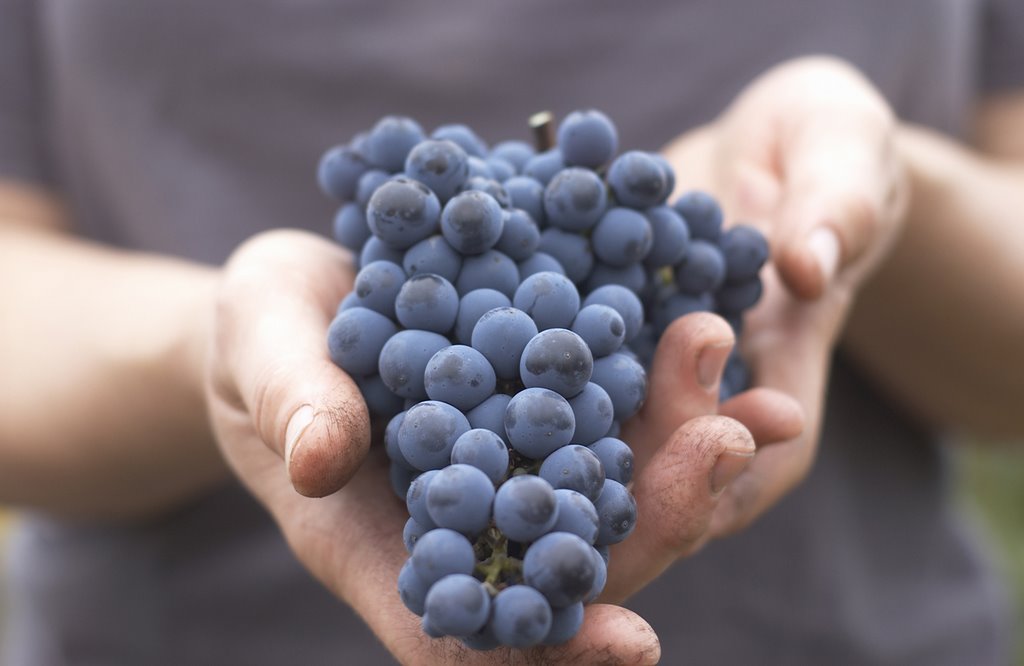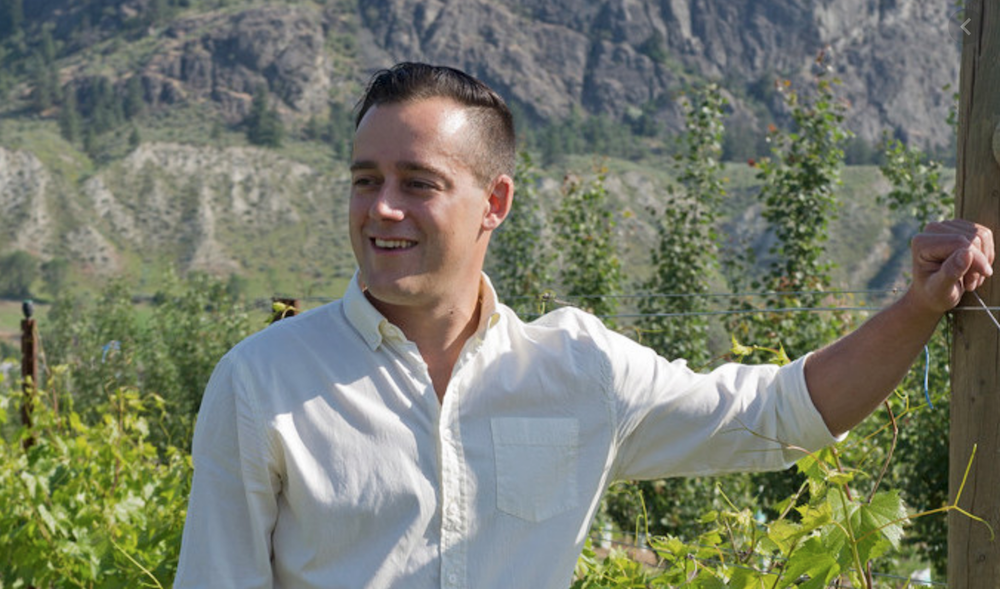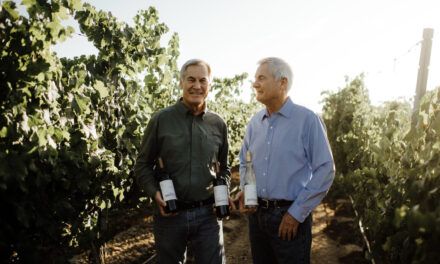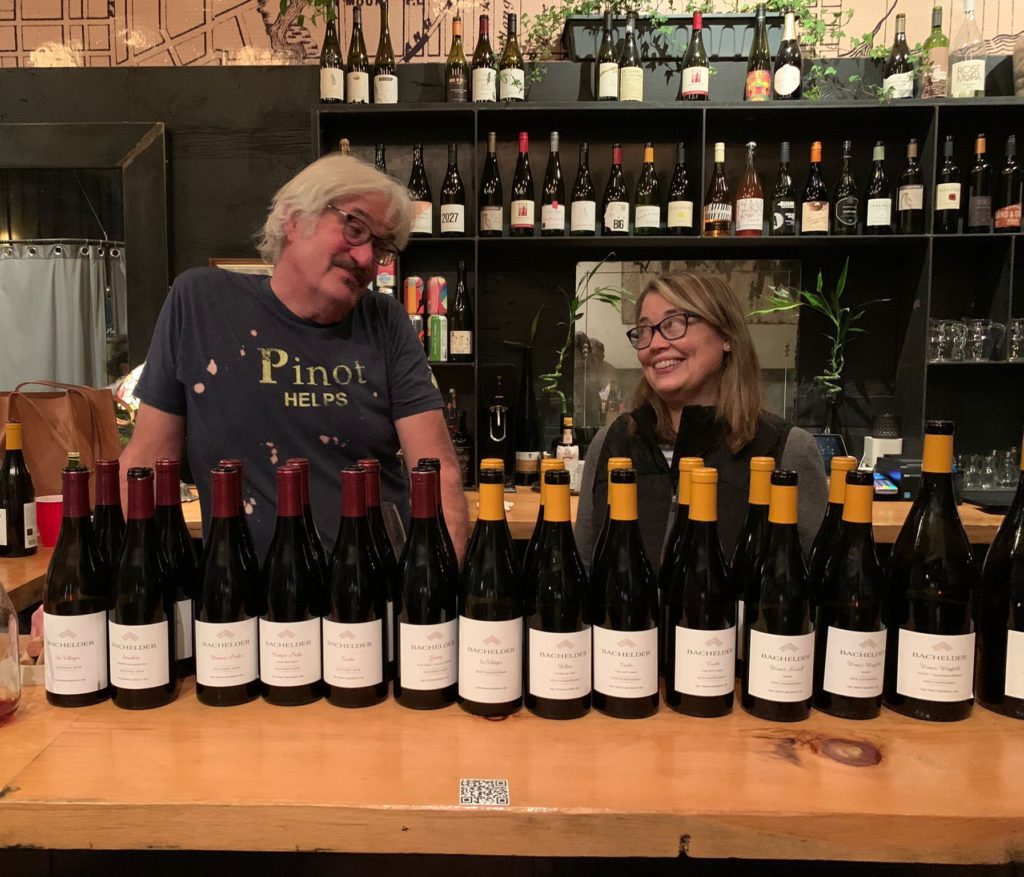
Vignerons Thomas Bachelder and Mary Delaney. Pic courtesy of Beverly Crandon.
This past Wednesday I gathered with a small group of wine folks to join vignerons Thomas Bachelder and Mary Delaney for a tasting of their wines at Chez Nous in Leslieville. Superficially the reason for gathering was to taste their catalogue of new releases from the 2019 vintage. The deeper purpose was to put a magnifying glass to Niagara terroir. Thomas led us methodically through the reds West to East and the white wines East back to West.
I’m a bit of a skeptic for the try-hard comparisons of Ontario to Burgundy, but considering this tasting exercise, I have mostly changed my mind. Wines pulled from vineyards just a couple of hundred metres apart displayed succinct differences that go beyond winemaking technique or ripeness at harvest. There were definite overarching similarities in the range and type of fruit character that shows up in the wines. The differences came down to the depth and concentration of fruit, where it mingles with structure on your palate and the personality of the wine as a whole.
Given that these terroirs are interpreted by the same winemaker there are also certain themes in the way they are made. Each year’s harvest is treated to a gentle press and native yeast fermentation. In the cellar Thomas treats the wines the same to the extent that varying lots sizes and yields allows. The wines undergo extended élevage in barrel – usually old French oak on their 2nd or 3rd year. He notes he prefers them once they have been seasoned by his own wines. There is a characteristic whiff of noble reduction on his wines that nods to his Burgundian training. The wines are bottled after careful consideration of their development with new releases offered in April and November each year.
My notes of the wines with tidbits about terroir follow below. Considering that wine tasting means mucking through the subjective layers that influence our taste perception, I feel it’s fair to offer a touch of context to my palate’s perspective. I like my acids striking, tannins in abundance and I’m a sucker for a floral wine. Oh and its also a Flower Day, so make of that what you will. I’m sensitive to alcohol that sits atop a wine’s flavours or otherwise interferes. The dimension and density of a wine have become increasingly central to how I experience a wine.
My favourite takeaway from this tasting was that the true diversity of styles that Niagara offers in its Pinot Noirs and Chardonnays. There were fruit-forward examples and earth-centric ones. Enough diversity of style that you could satisfy die hard Burgundy fans as well as those who rarely drink outside of California.
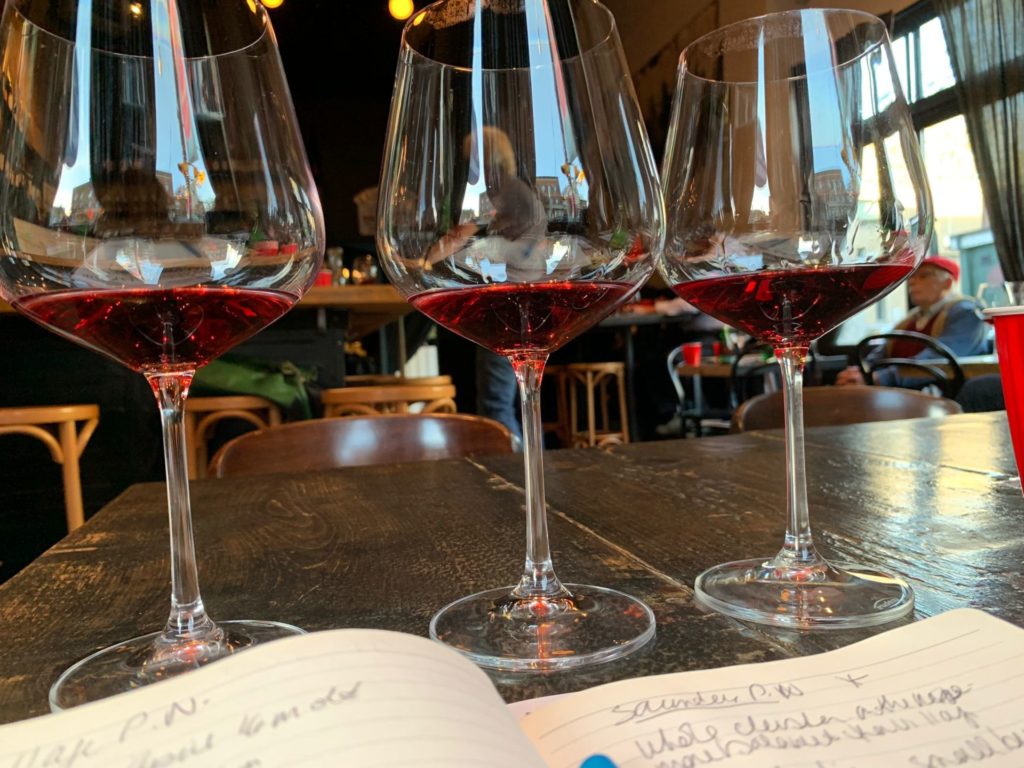
Pic courtesy of Beverly Crandon.
The Pinot Noirs
Village – Tightly wound, so served after a short decant. Juicy berries and soft florals. It unfolds gracefully on the palate with a bit of earth and a hint of caraway. A sanguine edge works as an interesting foil to the fruit and floral nose.
![]()
Saunders – The most aromatically open of the lineup. Sensual, bordering on obscene, the way a perfectly ripe fig conjures seductive thoughts. Lilacs and hyacinths leap from the glass. The fruit character is vibrant; the sweetest pomegranate. The firmest tannins in the lineup, but draped in velvet.
![]()
Wismer-Parke – Dark dense blackberry and cherry on the nose. More savoury, bringing spice box and forest floor to mind. The palate is more restrained and the fruit pulls back a touch tarter. It is delicious now, but the palate has some unwinding to do.
![]()
Wismer Parke- Wild West End – A bit more giving on the nose. Full of earth, sauvage, and funk. The soil at this site is iron and magnesium rich and the likely source of its earthiness. The nose is all smashed berries and wet forest floor. The fruit character is intense but more red cherry driven. Touch of cola and red Swedish fish on the palate [I had to Google what these were – Ed.]. The texture is all silk but pulls up short on the finish compared to some of the others.
![]()
Hanck – This is an intriguing wine; just 10 metres away from Wismer-Parke and such a different creature. This is the one that I revisit and linger over at the end of the tasting. The fruit is ripe and black or purple; huckleberry and black plum skin. Its so vibrant it almost hums. Its a bit understated in some way but the structure is tightly twined to the flavours and it draws this purity of fruit flavor right through the entire finish. Gives the wine a sense of motion.
![]()
Cuesta – A secretive sort of wine. This feels almost thin but not inconsequential. Cuesta is a cooler site and this is the last of the Pinot to be harvested each year. This Pinot is the crunchiest of the lineup with fruit bordering on rhubarb and cranberry. There is ample spice and a whiff of flint and smoke. The minerality is more central to the wine. I think this will turn stunning in a handful of years.
![]()
Lowrey Old Vines – Just beautiful. The sort of Pinot Noir that explains why wine folks are always so captivated by the grape. The fruit is the darkest and ripest of the lineup. This site is a bit of a sun-trap and just windy enough to keep the chill off the vines. It has a perfectly balanced trifecta of fruit, florals, and earth. It’s generous in flavour now, but the structure is substantial. This will age a good long while.
![]()
Lowrey Eastern Block – Old vines, planted in ’84 and ’88. A close relation of the Lowrey old Vines. Similar fruit character but more power here. A touch warmer here than the other Pinots but still very much balanced.
![]()
The Chardonnays
Village – Everything I want in good Village level Chardonnay. Sweet ripe apples, perfumed white blossoms, earthiness that hints at just foraged mushrooms and rock hopping through creeks. Easy going, well balanced fruit that lingers through a long finish.
![]()
Willms – An old vineyard wedged nearly equidistant between the lake and Niagara River. This is a citrus and earth driven Chardonnay, a touch more subdued on the nose. A hint of brown butter and turned forest floor. Ethereal texture with a great intensity of bright citrus flavour on the palate and the faintest suggestion of fresh greenery. This tastes like spring shaking off the winter.
![]()
Willms Puncheon Magnum If the barrel aged version tasted of spring then this puncheon-aged version tastes of Fall. Still the orchard fruit and ripe citrus range but much more savoury. The slightly sweet and earthy impression of parsnip or turnips still dusted in soil. The palate is savoury and richly textured. The kind of Chardonnay I’d hate to [get] blind next to a Gruner.
![]()
Bai Xu – An old vine site, Chardonnay clone 95 planted in 1981. A highly aromatic and voluptuous Chardonnay. The nose is overtly floral, paperwhites, and pear drop, with a bit of something tropical in the mix, maybe white pineapple or tart guava. The fruit sticks wantonly to the palate. It’s like eating a ripe mango, stripping flesh from the pit without regard for the juices running down your chin. The acids are really punchy and keep pace with the intensity of the fruit.
![]()
Cuesta – Once again the crunchiest and most mineral driven of the lineup. The white clearly benefits from the site’s cooler character. Crunchy green apple, lemon rind, crushed rocks. Struck flint, turned earth, and sandalwood leave the wine feeling textural and taut rather than lean.
![]()
Wismer Wingfield – One of the latest sites to ripen, sharp slope and high elevation. Surprising given its cool-site cred this shows tropical-edged fruit. To me its very sweet melon, green guava jam, poached yellow apples, the fruit is more exposed, silky with flavours that coat your palate and linger well through the finish.
![]()
Wismer Wingfield Puncheon Magnum – The site signature still carries, the fruit is sweet, honeydew melon, honeycrisp apples and candied lemon peels. Here the oak contributes more to texture than overt oxygenation. The minerality is more present The big difference compared to the barrel version is that, for me, this just comes across as more balanced between fruit, mineral and oak. Folks who prefer their Chardonnays fleshier will prefer the barrel aged edition.
![]()
Wismer-Foxcroft Nord– Northern parcel of the vineyard that shows a seas-spray mineral drive. Another aromatically stunning wine. Vibrant ripe lemon and apple lead with crushed rock and petrichor close behind. On second and third approach the nose reveals a floral woodsy tone that reminds me of the distinctive flavor of chewing on Indian Betel Nut, or Sopari. The fruit turns brighter on the palate and the wine is texturally lithe and long on the finish.
![]()
Saunders – silky, sweet fruit, lifted powdery white floral. The floral character seems to be a site signature. The palate again is light and silky with vibrant apple and meyer lemon character. Easy drinking and graceful.
![]()
Grimsby Hillside – A historic site – the furthest west vineyard in Niagara with a history of viticulture back to 1874. Distinct soils with granite and sandstone a major player. An interesting chameleon of a wine. The wine juxtaposes lacquered fruit sweetness with bitter, like a good orange marmalade. The nose is ripe navel orange, melon and yellow pineapple. It feels almost too forward, too lush and round but the acids are bright and give the wine an angular mid-palate. I think there is still some tinkering to do to get this site to show its best self, but this is hedonistic as is.
![]()
(All wines are rated out of a possible five apples)
Wines are available to purchase direct from the winery at BachelderNiagara.com
*pictures provided by Beverly Crandon*

